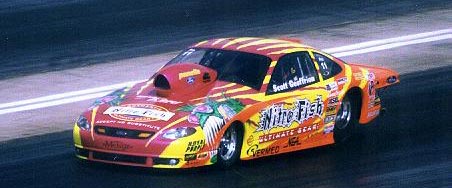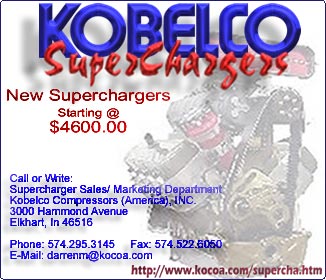|
<<
PREVIOUS PAGE

DRO: Well, your
program certainly is coming around, especially
after introducing the new Escort, so you've
got to be pleased with that.
Geoffrion: Yeah,
we went to the finals in Houston against my
buddy Kurt; I hadn't been to a final since I
guess 2000, so that was pretty neat. We had
a good race; 6.78 to a 6.79 and we both ran
204-plus, but he's just tough to beat right
now.
We don't have any runs on this racecar; I mean,
compared to him. We just tested for the first
time after Bristol; we tested for three days.
Up until then, we basically had just the runs
we made at national events, so it's pretty incredible.
DRO: You put a
new engine in yesterday for the final qualifying
session, but you had a problem with the line
lock before the burnout and didn't get to make
a pass.
Geoffrion: Yeah,
we put it in and it was unfortunate because
the air got a little worse and it was the perfect
situation. We had a game plan before the weekend
started in the sense
ADVERTISEMENT
 |
that
we wanted to slip that new motor in and see
what it would do in the last qualifying effort
if the air got a little worse and the track
got a little hotter. We wanted to see where
we would stack up and then make a decision on
what to run on raceday.
The motor that we have has got a lot of runs
on it, so we're flying it back to the Panellas
in California. They're awesome and I'm sure
they'll get it shined up for Englishtown. (Editor's
note -- The team installed a new engine before
Atlanta's first round, but lost to Taylor Lastor,
so both engines were sent back to engine builder
Bob Panella's shop for freshening up before
the E-town event.)
You know, for the short amount of time that
the Panellas have had to work on this engine
program, it's pretty incredible what they've
accomplished. We're just in the early stages
here and it seems like they're always finding
a little more here and a little bit more there.
The reliability factor is obviously important,
too, and this stuff stays together.
DRO: Is driving
the Ford any different from driving the Dodge
that you were in for so many years?
Geoffrion: Well,
the power curve is different. The Dodges were
more high winders, especially with the hemis
there at the end. You didn't have as much torque
at the bottom of the gear and you shifted them
higher. The Dodges I used to shift at about
96 or 9,700 (rpm), and you shift this one at
about 9,400. And this racecar that Don Ness
built is the nicest racecar I've ever had, by
far. It is the most stable; it is just an awesome
car.
DRO: Does that
make it easier for you to provide feedback as
a driver?
Geoffrion: Exactly.
It's got so much adjustability in it and it
seems like every little change we make, it shows
us something. It's not one of those cars that
doesn't respond to change.
|